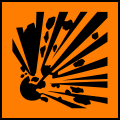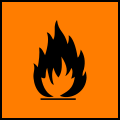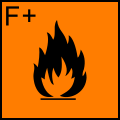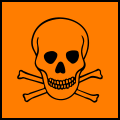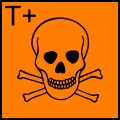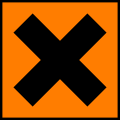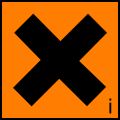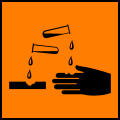Hazard symbol facts for kids
Hazard symbols are special symbols. They were made to warn people about dangers. Usually they are pictograms. Pictograms are small drawings that show what is happening (or what is going to happen, or what should happen) in a way that is easy to understand.
European hazard symbols
The European Union has made a few symbols that warn of dangers and that should be easy to understand. These are the hazard symbols for chemicals:
-
Explosive (E)
Example Trinitrotoluene -
Highly flammable (F)
(Can start a fire)
Example: Ethanol -
Extremely flammable (F+)
(Can easily start a fire)
Example: Hydrogen -
Toxic (T)
(This is a poison)
Example: Barium chloride, most acids -
Very toxic (T+)
(This also is a poison, but is more dangerous)
Example: Nicotine -
Irritant (Xi)
(Can cause damage to the skin, or the eyes)
Example: Fumaric acid and bleach -
Corrosive (C)
(Causes damage to the skin or the eyes)
Example: Hydrochloric acid -
Dangerous for the environment (N)
Example: Lindane
The 'n' in Harmful (Xn) stands for the French word nocif (harmful) and the Italian word nocivo (noxious).
Images for kids
-
Sign on a fence around the Beromünster Reserve Broadcasting Tower in Switzerland, warning of high voltage and danger of death
See also
 In Spanish: Símbolo de riesgo químico para niños
In Spanish: Símbolo de riesgo químico para niños


